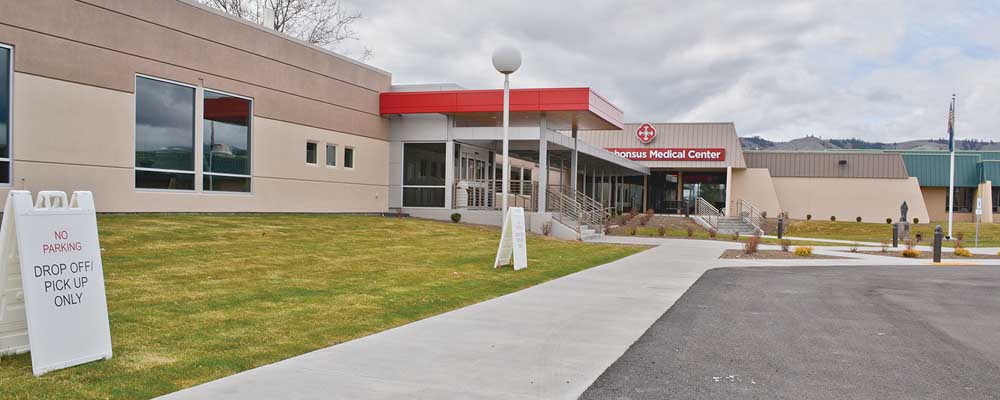Fed report criticizes Saint Alphonsus’ communication, suggests possibility for new birth center
Published 6:00 am Friday, September 22, 2023

- Saint Alphonsus Medical Center-Baker City announced on Thursday, June 22, 2023, that it would be closing the hospital's birth center. Saint Alphonsus Health System, which includes hospitals in Baker City, Ontario, Nampa and Boise, is owned by Trinity Health of Michigan, a nonprofit Catholic health system that operates 92 hospitals in 22 states.
BAKER CITY — A 15-page report from a team of federal employees who visited Baker City recently to assess the situation after the closure of the birth center at Saint Alphonsus Medical Center criticized the hospital for what the report calls “inconsistent and unclear” communication with local residents and the ambulance and LifeFlight emergency providers.
The report was compiled by a team from the U.S. Public Health Service Commissioned Corps.
Team members spent more than a week in Baker County, interviewing local residents about the effects of the closure of the birth center on Saturday, Aug. 26, and also speaking with administrators from Saint Alphonsus.
The report concludes that the closure of the birth center “may have a significant and potentially life-threatening impact on pregnant patients and families in this underserved region and will have the greatest impact on those low-income and marginalized patients who are already disproportionately vulnerable.”
In a section titled “Communication,” the federal team noted that Saint Alphonsus did not issue a press release confirming that the birth center was officially closed after Aug. 26. The hospital, on a recommendation from federal employees, updated the Saint Alphonsus website Aug. 29 so the site no longer advertised the birth center.
The report also states that neither Metro West Ambulance (now Priority Ambulance) nor LifeFlight was “aware of the specifics of the post-closure transition plan and what their roles would be moving forward.”
The complete report is available at www.bakercityherald.com. The report points out that the lack of obstetric services in rural areas is not unusual.
“Almost half of U.S. rural counties do not have a hospital with obstetric services,” the report notes. “Between 2004 and 2014, over 150 rural communities experienced loss of hospital obstetric services. As a result, less than half of rural women have access to perinatal services within a 30-minute drive.”
Recommendations
The report concludes with a list of recommendations, including the potential opening of a stand-alone birth center.
The report doesn’t include a proposal for how that could happen. It does, however, list as possible options either allowing a different company to operate a birth center using the existing beds and equipment in the hospital, or establishing a public, taxpayer-funded health district.
The latter is the model under which hospitals in Burns, John Day and Enterprise operate. All of those, despite being in towns and counties with substantially smaller populations than Baker City and Baker County and with fewer births, have birth centers.
The report recommends Baker County officials work with the Oregon Office of Rural Health to “help assess future options for reestablishing obstetric services in Baker County.”
Shane Alderson, chairman of the Baker County Board of Commissioners, said he has discussed with Dina Ellwanger, Saint Alphonsus Eastern Oregon president, the possibility of having a separate entity operate a birth center inside Baker City hospital.
He said Ellwanger told him the hospital would consider such an option. But Alderson said either that option, or a stand-alone birth center somewhere other than the hospital, would involve challenges, both logistical and financial.
A new birth center would need to have constant access to an operating room and anesthesiologist in case a caesarian section was needed, he said.
In either situation, Alderson said, the stand-alone birth center would still depend on a commitment from Saint Alphonsus for those emergency situations.
“I do think it’s possible, but there are obstacles,” he said.
Hospital officials, both here and elsewhere, say birth centers cost more money to operate than they produce in revenue. Hospitals can operate birth centers by subsidizing the loss with revenue from their other services. But Alderson notes that there wouldn’t be other services with a stand-alone birth center.
“It would have to be subsidized,” he said.
That subsidy could potentially be built into a public, taxpayer-funded health district, he said.
The report also addresses the workforce needed to operate a birth center — a key issue since Saint Alphonsus administrators cited a shortage of nurses as the reason for closing the center.
The report suggests that, if a birth center reopens in Baker City, the county would seek help from state and federal programs that could help recruit nurses.
U.S. Sen. Ron Wyden, who had a town hall meeting in Baker City on June 25, three days after Saint Alphonsus announced the pending closure of the birth center, had arranged to bring six federal nurses to work in the birth center for six months.
But Saint Alphonsus officials said they would have needed at least nine nurses to keep operating the birth center beyond Aug. 26. Wyden lauded the Public Health Service’s visit and report, which he said was the nation’s first prompted by the closure of a rural birth center.
“Its assessment confirms how Saint Alphonsus’ abrupt decision to terminate OB services — rejecting the offer of U.S. public health nurses — put expectant parents at serious risk by eliminating local care and forcing moms in labor to travel sometimes dangerous mountain roads for care,” Wyden said. “I heard the community’s concerns loud and clear at my June 25 town hall in Baker City. And I’ll use this report that clearly identifies those health risks as well as related economic dangers to stay on the case with Baker County and the entire community to find long-term solutions that fill the void left by Saint Alphonsus.”
Among the other recommendations in the report:
• That Saint Alphonsus track the effects of the birth center closure, including the number of pregnant women transferred to other hospitals for delivery, the number of deliveries in the emergency department, and “adverse maternal or infant outcomes related to ED deliveries or transfers.”
• That Saint Alphonsus inform all pregnant women about options for delivery, including distance to the nearest birth centers and options for emergency transportation.
• That Saint Alphonsus and the county work to set up a phone hotline that explains how women can get maternal care.
• That Saint Alphonsus “rebuild trust and relationship with community leaders and stakeholders through effective, timely and transparent communications regarding any planned changes to hospital services.”
• That Saint Alphonsus “provide greater transparency and timely communications on changes in hospital services” to the hospital’s advisory board.New mother was interviewed by federal teamPaige Witham, of Baker City, was among the local residents who were interviewed by the Public Health Service officials during their visit to Baker City.
Witham, who is the daughter-in-law of county commissioner Christina Witham, gave birth to a son, Thomas, on June 12 at Saint Alphonsus in Baker City. Ten days later, Saint Alphonsus announced that the birth center would close July 30 (officials later changed the date to Aug. 26).
Paige Witham, who has lived in Baker City since May 2022, said she told the federal team that the birth center at Saint Alphonsus was one reason she was excited about moving to Baker City, where her husband, Eli, grew up.
“I had heard great things about (the birth center),” she said.
Witham said she was “shocked” by the June 22 announcement that the center, where she had so recently been a patient, was going to close.
She said she spoke to the federal team along with several other local women who are all members of a moms group.
“We all spoke very highly of the experiences they had at the birth center,” Witham said. “I really wanted to convey that it’s a necessary service that we should have in Baker City and for the surrounding areas. We were able to be quite candid.”
Witham said she understands, as the report points out, that operating birth centers is a challenge, especially in rural areas.
But she noted that hospitals in smaller towns than Baker City, such as John Day and Enterprise, continue to operate birth centers.
Witham said that during her conversation with the federal officials, it seemed to her that they believed creating a public health district, the model used in those two towns and in Burns, might be Baker City’s only feasible option to have a birth center.
Witham said she is frustrated that Saint Alphonsus didn’t commit to keeping its birth center open for even six more months.
Although she said it likely would take longer than that to start a new birth center, the additional time would at least have given local officials a chance to better prepare to help women who now have to go elsewhere, such as La Grande, Ontario or Boise, to have their babies.
“They just gave us no room for options,” Witham said.
Saint Alphonsus Health System released a written response on Friday, Sept. 15 to the report from the U.S. Public Health Services regarding the Aug. 26 closure of the birth center at the Baker City hospital.
The statement:
“We appreciate the U.S. Public Health Services Commissioned Corps (USPHS) for their engagement and assessment of how to improve access to maternal care services in Baker County. The report affirms there were no immediate solutions for the staffing shortages that necessitated the difficult decision to discontinue maternal care services. We are disappointed that the report failed to include all the work that our dedicated team and community emergency response providers have engaged in to ensure the best and safest care possible for the expectant mother. We agree it is of utmost importance to ensure protocols are in place to support expectant Baker County families. In fact, we have already implemented many of their recommendations.
“Safety and a commitment to those experiencing poverty are two of our core values, and as a Critical Access Hospital, it is our responsibility and privilege to collaborate with local public health authorities, elected officials, business, and community leaders to ensure the safety and well-being of the Baker County region. We are proud and committed to being part of the Baker County community and continue to be open to further collaboration with County Commissioners, Emergency Preparedness, Baker County Health Department, Eastern Oregon Coordinated Care Organization (EOCCO), and the Oregon Health Authority, with the desire to build a sustainable solution that best serves the Baker County community.”
The Baker County chapter of Safe Families for Children is offering to help families who need child care during a pregnancy or childbirth.
Safe Families for Children, which operates through the Northeast Oregon Compassion Center, has seven families, which have gone through a screening process, that can temporarily care for children whose parents have doctor’s appointments or who are in the hospital while the mother delivers a child.
Andy Micka, director of Safe Families for Children, said the organization is looking for other families who can help. Applicants must be at least 25 years old, emotionally and financially stable, mature, law-abiding, health and active, according to a press release from Baker County.
Applications and other information are available at https://safe-families.org or https://baker-county.safe-families.org/ or by calling 541-523-9845.





